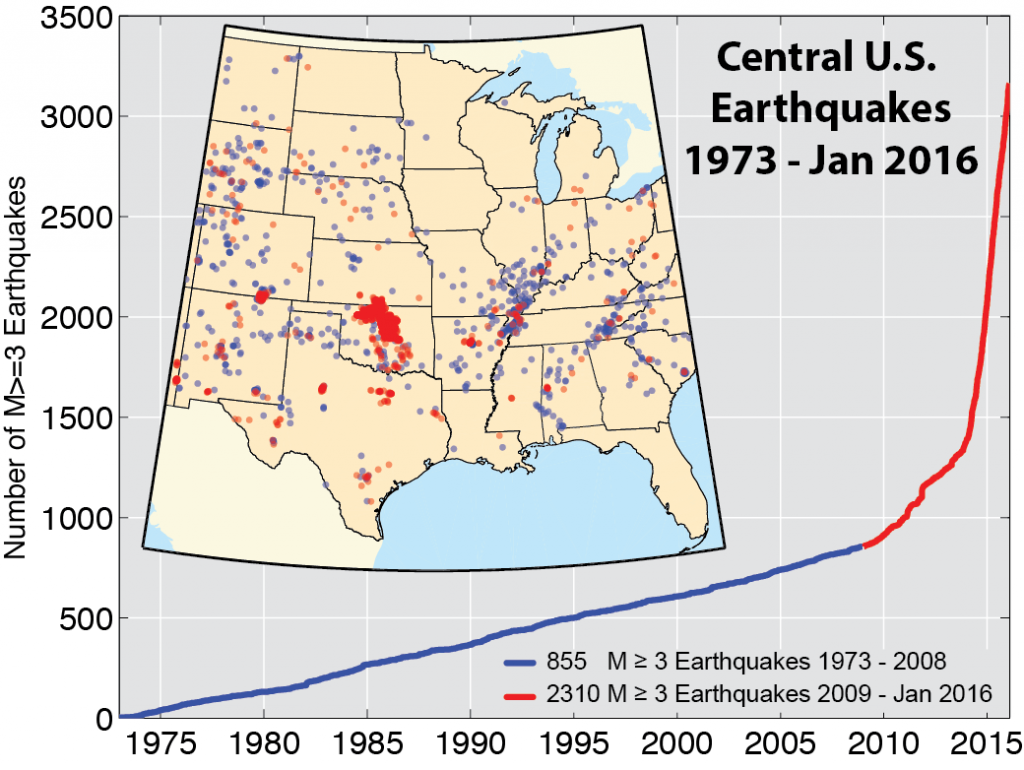13 April 2016
2012 Texas earthquakes may have been man-made
Posted by Lauren Lipuma
By Anton Caputo
The most comprehensive analysis to date of a series of earthquakes that included a 4.8-magnitude event in East Texas in 2012 has found it plausible that the earthquakes were caused by wastewater injection. The findings also underscore the difficulty of conclusively tying specific earthquakes to human activity using currently available subsurface data.
The study focused on an earthquake sequence near Timpson, Texas, and builds on previous studies that have associated these earthquakes with wastewater injection. The study was published today in the Journal of Geophysical Research: Solid Earth, a journal of the American Geophysical Union.
To determine whether the earthquakes could have been caused by the injection of fluid into the underground geological formation, researchers built the first computer model for this site that simulates the effects of fluid injection on the stability of the fault that potentially generated the earthquakes. In their simulations, researchers used a range of likely values for input parameters. Those parameters included physical properties of the reservoir and the orientation of the fault. Earthquakes were generated using a certain range of input parameters, but no earthquakes were generated in simulations using a wider set of equally probable parameters.
The 4.8-magnitude earthquake researchers looked at in this study occurred on May 17, 2012. It was the largest ever recorded in the area and followed a series of smaller earthquakes that started in April 2008, some 17 months after two wastewater injections wells began operating nearby. The wells are used to dispose of saline water that is produced with oil and gas from deep hydrocarbon reservoirs.

Earthquakes with a magnitude of 3.0 or larger in the central and eastern United States from 1970–2016. The rate of earthquakes per year increased sharply around 2009. While Oklahoma and Kansas are ranked highest in earthquake activity associated with oil and gas operations, Texas has experienced several earthquakes that have been linked to wastewater injection.
Credit: U.S. Geological Survey.
The researchers tested a number of likely scenarios to assess if the volume and rate of fluid injected into the disposal wells were high enough to cause nearby faults to slip. Earthquakes occur when faults slip, a process that is aided by the high pressure generated in the porous rock formation during wastewater injection, but also occurs by natural tectonic processes.
Previous studies relied on the timing and proximity of wastewater injection to earthquakes to decide if earthquakes were induced by human activity. This was the first to simulate the mechanics of an earthquake generated by water injection for this site.
“It is part of a continuing research effort by The University of Texas at Austin,” said Peter Eichhubl, a senior research scientist at the Bureau of Economic Geology, the State Geological Survey of Texas and the University of Texas Jackson School of Geosciences in Austin and lead author of the study. “We used a more rigorous approach than previous studies, but our analyses are limited by the availability of robust, high-quality data sets that describe the conditions at depth at which water is injected and earthquakes occur. This study demonstrates the need for more and higher quality subsurface data to properly evaluate the hazards associated with wastewater injection in Texas.”
The relationship between seismic events, or earthquakes, and human activity has become more of a concern in recent years. While Oklahoma and Kansas are ranked highest in earthquake activity associated with oil and gas operations, Texas has experienced several earthquakes that have been linked to wastewater injection. The University of Texas at Austin is taking a leading role in the ongoing research. By the end of the year, the Bureau of Economic Geology will be operating a statewide network of seismographs called TexNet that will monitor, locate and catalog seismic activity with magnitude of 2 and greater.
TexNet will improve the state’s ability to more rapidly and more accurately investigate earthquakes. Eichhubl said the data collected will help understand baseline seismicity and in so doing assist future studies that try to determine possible links between human activity and seismic events.
—Anton Caputo is Director of Communications for the University of Texas Jackson School of Geosciences. This post originally appeared as a press release on the University of Texas website.


 GeoSpace is a blog on Earth and space science, managed by AGU’s Public Information staff. The blog features posts by AGU writers and guest contributors on all sorts of relevant science topics, but with a focus on new research and geo and space sciences-related stories that are currently in the news.
GeoSpace is a blog on Earth and space science, managed by AGU’s Public Information staff. The blog features posts by AGU writers and guest contributors on all sorts of relevant science topics, but with a focus on new research and geo and space sciences-related stories that are currently in the news.